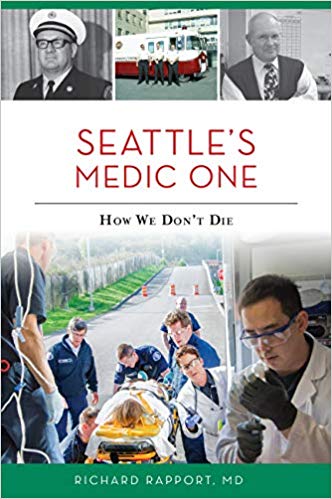By Dr. Richard Rapport

“Seattle’s Medic One: How We Don’t Die” by Dr. Richard Rapport can be read as an informative account of Seattle’s pioneering public health services, a demonstration of using creative thinking to overcome insurmountable obstacles, and — in a political climate where the word “socialism” frightens some — an example of what a socialized health care service for everyone could look like.
Rapport focuses on three key players who envisioned, organized and sustained Medic One. Len Cobb, director of Harborview Medical Center’s division of cardiology, initiated the emergency care service after reading about patients in Belfast, Ireland, who had survived cardiac arrest before even arriving at the hospital; first responders brought the emergency room to patients rather than the other way around.
Dr. Cobb saw the fire department as an existing system capable of addressing health emergencies where they happened, and Seattle Fire Chief Gordon Vickery directed resources to provide training and equipment to a select group of firefighters who would become the best-trained medics in the nation.
Rounding out the trio was emergency room director Dr. Michael K. Copass, who during 35 years at Harborview “made absolutely certain that all patients, no matter what was wrong with them, where they came from, what shade of skin they had, what kind of insurance they had or didn’t, or what language they spoke, were cared for perfectly.”
Dr. Kathleen Jobe, now an associate professor of emergency medicine at the University of Washington, sums up the three men’s contributions this way: “Len Cobb had the idea for Medic One, and Vickery helped it get going, but Mike Copass built it.” Rapport adds one more credit: “The ambitious firefighters who became the early paramedics are another major reason that Medic One succeeded in Seattle.”
Before Medic One, Seattle firefighters had responded to thousands of medical emergencies. But residents needed a faster and more effective life-saving service regardless of their location or ability to pay, and there needed to be an equitable way to cover the costs of this new service. These are similar to the challenges many currently face when it comes to obtaining health care coverage.
When Cobb asked Vickery if he would expand firefighters’ services to include paramedic treatment to victims of heart attacks before transporting them to the emergency room, Vickery supportive. He enlisted the city government’s cooperation with Dr. Cobb and Harborview’s staff to train 19 enthusiastic firefighters in managing cardiac health emergencies. In 1970, Seattle rolled out its first Mobile Intensive Coronary Care Unit.
Rapport’s narrative of Medic One’s successful adaptation of existing resources to save lives shows one workable approach to designing and executing a comprehensive delivery system for all, not just for those who can pay for it. This accomplishment was made possible through government, nonprofits and private businesses working together, in a spirit of cooperation Rapport attributes to public health officials and departments being “relieved of McCarthy-era risks of having the communist stigma nailed to them.”
Finding funding was another issue. When planning for Medic One began in 1969, Seattle’s economy was in decline and the unemployment rate was more than 10 percent. Rapport notes that “competing forces were after every cent that could be squeezed from the city budget.”
But at the same time, technological improvements and improved building codes meant fire crews departed their stations less frequently to fight big city fires. And there was a bipartisan recognition that the effort would require tax increases. “One reason that King County Medic One has always been funded by a special levy rather than individual insurance is to guarantee that all citizens are protected,” says Rapport. Since the levy was introduced, it has failed just once, showing that “the citizens of Seattle found a way to pay for keeping people from dying.” It’s a story that could guide today’s debate on creating a more universally accessible health care system.
“Seattle’s Medic One: How We Don’t Die” by Dr. Richard Rapport, The History Press, 192 pp., $21.99
Discover more from Post Alley
Subscribe to get the latest posts sent to your email.
